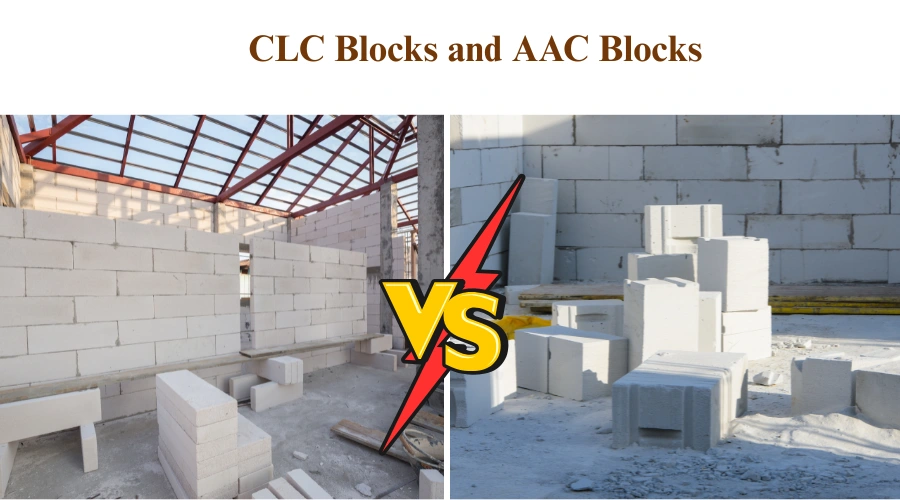Wondering how to create a building that stands the test of time? What if the answer lies in the blocks that complement the foundation? Allow me to introduce you to a construction solution that’s been quietly shaking up the industry— CLC blocks. These lightweight, durable, and sustainable materials are more than mere building blocks, they’re dictating the future of construction. Stay tuned as we dive right into how these blocks are setting new standards for strength and efficiency.
What are Cellular Lightweight Concrete (CLC) Blocks?
Cellular Lightweight Concrete or CLC Block is a lightweight concrete that is made using lightweight concrete, fly ash slurry and pre-formed foam. During the manufacturing process, the pre-formed foam is mixed with the cementious material, to make the block lightweight, reduce setting time, and offer insulating properties.
Composition of CLC Blocks
Portland Cement, fly ash, water, and foaming agent are the primary components of CLC bricks. For the manufacturing of 1 cubic meter of CLC bricks, approximately 5 bags of Ordinary Portland Cement of 53 grade (OPC-53), and 500 kilograms of fly ash are used. For the same proportion, 1.2 kilograms of foaming agent is diluted with 30 litres of water.
Benefits of CLC Blocks
- These are lightweight blocks with density in between 300 and 1800 kg/m³.
- They are blocks made from fly ash as well as industrial waste, which makes them green too as far as the casting process is concerned. There are really no harmful effluents during their manufacturing process.
- They do possess good thermal insulation properties, thus keeping the surface cool during summer and warm during winter, hence energy efficient.
- It effectively reduces noises from the outside and creates a nice peaceful setup inside the structure.
- It has a relatively lower water absorption capacity, unlike other materials. This prevents the structure from cracks and damage to the walls.
- It has excellent fire protection for up to 4 hours and has fire ratings higher than clay bricks and dense concrete.
- These blocks are lightweight and easily handled, installed, and reduce all the costs associated with transportation, and skilled labour.
Manufacturing Process of CLC Blocks
Preparation of Raw Materials
The materials that are essential for CLC brick manufacture include cement, fly ash, water, foaming agent, and additives. To manufacture a 1 cubic meter CLC block, it requires around five bags of OPC 53-grade cement and 500 kg fly ash.
Foaming
A foam generator can be used to generate a stable foam by using a foaming agent. About 1.2 kg of foaming agent is mixed with 30 litres of water and added to the concrete mixture. The foam forms air bubbles in the mix and leads to lightweight blocks.
Weighing
One litre of cement-foam bonded slurry is extracted from the mixer and weighed for density. If the right density is attained, the slurry becomes ready for moulding.
Moulding
The foamed concrete mixture is transferred into pre-designed moulds or formwork, made of plastic or steel. They give the desired shape and size of the blocks.
Curing
The blocks are demoulded after 24 hours and kept for curing for 28 days to gain the necessary strength and stability. Throughout the curing period, the block is either naturally cured or using steam curing.
Drying
The cured blocks are kept dry in a controlled environment, which helps in further strengthening and reducing the moisture content.
Quality Checks
After drying, the CLC block samples are set to undergo quality checks, before being dispatched to sales and construction sites.
Applications of CLC Blocks
- These blocks can be used for acoustic construction, where soundproofing is crucial.
- They can be used to precast exterior walls due to their high durability and longevity
- The rustic insulation and waterproofing make it apt for water-prone areas.
- They are completely eco-friendly and can be used for green construction.
- It can be used for high-rise buildings due to its lightweight yet durable properties.
- They offer good thermal insulation, which keeps the building cool for a long time, and are suitable for buildings that prioritise air conditioning and sustainability.
- These blocks are affordable, and are suitable for low-cost housing and buildings with budget constraints.
Standard Sizes of CLC Blocks
CLC bricks are available in four different dimensions,
- 600 mm x 200 mm x 100 mm
- 600 mm x 200 mm x 150 mm
- 600 mm x 200 mm -x 200 mm
- 600 mm x 200 mm x 250 mm
Key Differences Between CLC Blocks and AAC Blocks

| Parameters | CLC Blocks | AAC Blocks |
| Basic raw materials | CementFly ashWaterFoam | CementLimeSpecially grounded sandAeration compoundHigh primary energy input |
| Production process and set-up | Using a ribbon mixer and foam generator | Produced only in a well-established plant equipped with a steam boiler and high-pressure autoclaves |
| Dry density | 600 / 800 kg/m2 | 400 / 700 kg/m2 |
| Compressive Strength | 30- 40 kg/cm2 | 20- 40 kg/cm2 |
| Usage | Thermal insulationPartitionsNon-load bearing blocks | Non-load bearing panelsBlocks |
| Aging | Gains strength with age (like conventional concrete) | No aging, loses strength, if not protected against humidity |
| Thermal conductivity (W/mK) | 0.09 – 0.12 (depending on density) | 0.09 – 0.15 (depending on density) |
| Eco-friendliness | Pollution freeNo primary energy consumptionConsumes fly ash (a hazardous industrial waste material) | Pollution freeHigh energy consumption |
Conclusion
To sum it up, CLC blocks are an innovative solution that can transform construction with their stacked properties. They are lightweight, durable, and sustainable, creating a new standard for building materials. Whether you are looking to improve efficiency, reduce environmental impact, or create durable structures, they fit right in. As construction continues to evolve, and people opt for sustainability, they could be a great choice for a resilient future.

